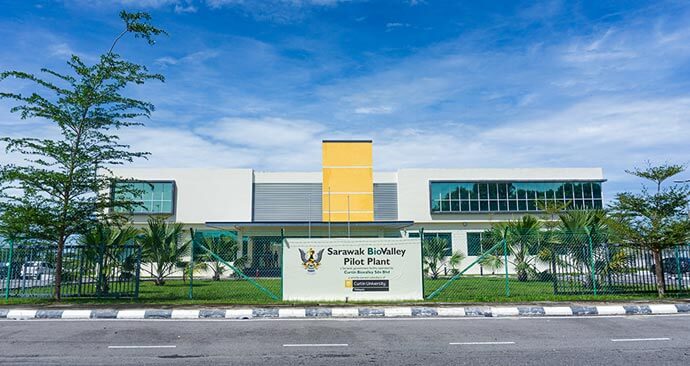Miri – 22 September 2021 – The recent online symposium on infrastructure development jointly hosted by The Institution of Engineers Malaysia (IEM) Miri Branch and Curtin Highway Infrastructure Research and Innovation Hub (CHIRI) of Curtin University Malaysia (Curtin Malaysia) saw Federal Senior Minister of Works Dato’ Sri Haji Fadillah Yusof and Sarawak Minister of Transport Datuk Lee Kim Shin giving insights into the status of various projects such as the Pan-Borneo Highway, Sarawak-Sabah Link Road, Sarawak Coastal Road & Second Trunk Road and Kuching Urban Transportation System projects.
Themed ‘Challenges and Opportunities of Infrastructure Development in Borneo’, the two-day symposium was attended by over 200 participants from the public and corporate sectors and academia.
Dato’ Sri Haji Fadillah was the symposiums plenary speaker, whilst Datuk Lee was one of the keynote speakers, along with Datu Haji Ismawi Haji Ismuni, Chief Executive Officer of Regional Corridor Development Authority (RECODA); Ir. Lau Hieng Ung, Director of Sarawak Sewerage Services Department; Ting Ching Zung, Vice-President of Strategy and Corporate Development, Sarawak Energy Berhad; Ts. Andy Tiong Meng Jun, Senior Professional Services Manager of PCSS Consultancy Sdn. Bhd.; Ir. Tan Kok Jyh, Director of PY Konsep Perunding Sdn. Bhd., Sabah; and Ir. Dr. Achmad Wicaksono, Associate Professor of Transportation Engineering at Universitas Brawijaya, Malang, Indonesia.
According to Dato’ Sri Haji Fadillah, works on the 425 kilometre Sarawak-Sabah Link Road connecting Sarawak and Sabah from Miri is expected to start this month and will be completed in 2026. He said the road is expected to spur the growth of eco and agro-tourism in the surrounding areas apart from providing easier access to education and healthcare.
On the Pan-Borneo Highway project, Dato’ Sri Haji Fadillah said work progress on the 786 kilometres of road and bridges from Telok Melano to Miri in Sarawak was now 70 per cent completed and Sabah notched 56 per cent completion of the proposed 706 kilometre road from Sindumin to Tawau.
He said the challenges of the Pan-Borneo Highway project are limited access to sufficient manpower and construction materials; insufficient local qualified contractors and subcontractors; difficult topographical terrains, limited funding for planned and earmarked projects; and policy and regulations in implementation.
Dato’ Sri Haji Fadillah said the construction industry in Malaysia must embrace construction industry needs to fully embrace IR 4.0 by using less unskilled workers and more automation. He added that he looked forward to the symposium participants supporting the government’s efforts by leveraging on technologies and data systems, innovation and automation at every level of their operations to build quality and sustainable infrastructure.
Datuk Lee, who focused on transportation development in Sarawak, highlighted various projects being implemented by the Ministry of Transport Sarawak (MOTS), including the Kuching Urban Transportation System (KUTS) which is set to become the backbone of the public transport system in Kuching and transform Kuching into a dynamic regional city.
He said Sarawak, with its large area and sparse population, faced many challenges in facilitating development of its land, riverine and air transport, and port facilities. Nevertheless, the state offers many opportunities in its transport sector and these include projects to improve river navigation infrastructure, integrating land and riverine connections for the transportation of agricultural produce, better management of land public transport and infrastructure, and use of new smart technologies.
Meanwhile, Datu Haji Ismawi said new strategic master plans have been set in place for Kapit and Bakun to benefit from Indonesia’s relocation of its capital to Kalimantan.
According to Datu Haji Ismawi, Kapit will be the closest urban centre in Sarawak to the new capital, which may be sited in East Kalimantan. He said that in the years to come, more people would be attracted to living and working in Kapit as the property sector and industries will grow.
The advancement of alternative renewable energy by Sarawak Energy Berhad (SEB) was highlighted by its Vice-President of Strategy and Corporate Development, Ting Ching Zung. He cited the company’s hydrogen production plant and Batang Ai floating solar power projects as good examples, and also shared SEB’s acceleration plan for rural electrification and interconnection projects between Sarawak and Sabah and Sarawak and Kalimantan. He said it is SEB’s vision to be a renewable energy powerhouse in Southeast Asia.
Sarawak Sewerage Services Department’s Ir. Lau shared some of the challenges faced in the implementation of sewerage projects in Sarawak. He said the Sewerage Services Department aims to develop financially and environmentally sustainable systems for the whole of Sarawak, which will be achieved through continued development of centralised sewerage systems for major urban centres, and septic sludge treatment plants for smaller towns and settlements.
The symposium participants also learned about ongoing projects in Sabah from PY Konsep Perunding’s Ir. Tan Kok Jyh, who gave insights into the Pan-Borneo Highway in Sabah, Sapangar Bay Container Port and ammonium urea plant development in the state. He said the container port development has attracted world-class companies to invest in the Kota Kinabalu Industrial Park, and that good infrastructure is very important for accelerated economic growth and poverty alleviation in Sabah.
Ir. Dr. Achmad meanwhile gave an Indonesian perspective, presenting an overview of recent transportation infrastructure policy in Kalimantan, as well as the development plans for border areas between Indonesia and East Malaysia and the new Indonesian capital. He said better connectivity between Kalimantan and the East Malaysian states will augur well for the economic growth of Borneo on the whole.
Also attending the symposium were Deputy Director (Corporate Affairs) of JKR Sarawak Ir. Wisil Anak Lichok, President of IEM Malaysia Ir. Ong Ching Loon, Chairman of IEM Miri Branch Ir. Sean Wong Siong Ung, Curtin Malaysia Interim Deputy Pro Vice-Chancellor Professor Vincent Lee Chieng Chen, and representatives from other IEM branches, government agencies and industry, and Curtin Malaysia’s Faculty of Engineering and Science.
In his speech at the start of the symposium, Professor Lee said it was a great honour for Curtin Malaysia and IEM Miri Branch to have government leaders at both the federal and state levels, as well as heads of government agencies, industry professionals and academics, participating as keynote speakers.
“Infrastructure development is crucial to Malaysia’s national development, and the dissemination of critical information, cutting-edge technology and research is important towards creating future development and improvements,” Professor Lee remarked.
“At Curtin Malaysia, we continually aim to create linkages and cooperation between academia, government and industry, and innovative solutions for the infrastructure development sector and engineering industries.”
IEM Malaysia President Ir. Ong, meanwhile, said whilst the vast terrain and sparsely distributed populations of Sarawak and Sabah posed unique challenges in infrastructure development, efficient infrastructure will benefit the population in more ways than one, and it presents a great opportunity to reduce the inequality among communities and uplift the well-being of the people, especially those living in the interior.
He said he was delighted to see various infrastructure projects taking place in Borneo, particularly the Pan-Borneo Highway, and also the Kuching Urban Transportation System in the Greater Kuching region and the Sabah – Sarawak Link Road.
Day 2 of the symposium included a panel session on Building Information Modeling (BIM) presided by Ir. Dr. Wong Kwong Soon of Curtin Malaysia, Ts. Andy Tiong Meng Jun of PCSS Consultancy Sdn. Bhd., Ir. Dr. Angelia Liew San Chuin of Swinburne University Sarawak Campus, and Ts. Dr. Gerald Sundaraj of CIDB Malaysia.
The establishment of CHIRI and our other research centres at Curtin Malaysia, including the multi-disciplinary Curtin Malaysia Research Institute, the Sarawak government-funded Sarawak Biovalley Pilot Plant and a soon-to-launch sustainable aquaculture research centre, have epitomised Curtin Malaysia’s commitment through the years towards enhancing its research prowess and contributing to the pool of knowledge, as well as contributing to Curtin University’s vision to be a scientifically-based solutions provider to industry and global leader in research and education.
Information on Curtin Malaysia can be found on its website at www.curtin.edu.my, or look for Curtin Malaysia on Facebook, Twitter, Instagram, YouTube, or LinkedIn.
Online Education Fair 线上教育展
Curtin University Malaysia (Curtin Malaysia)
科廷大学马来西亚分校
https://edufair.fsi.com.my/curtin














